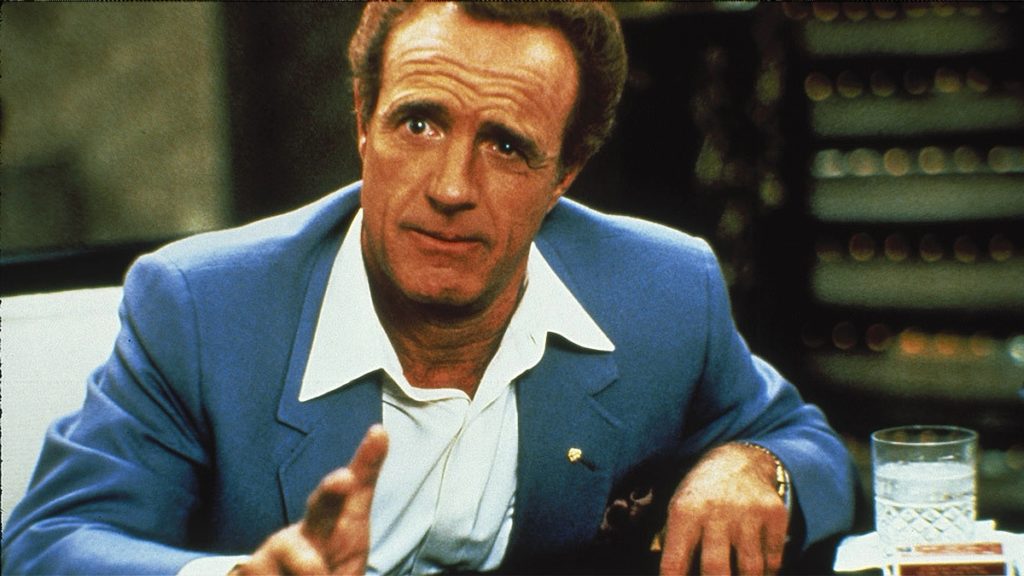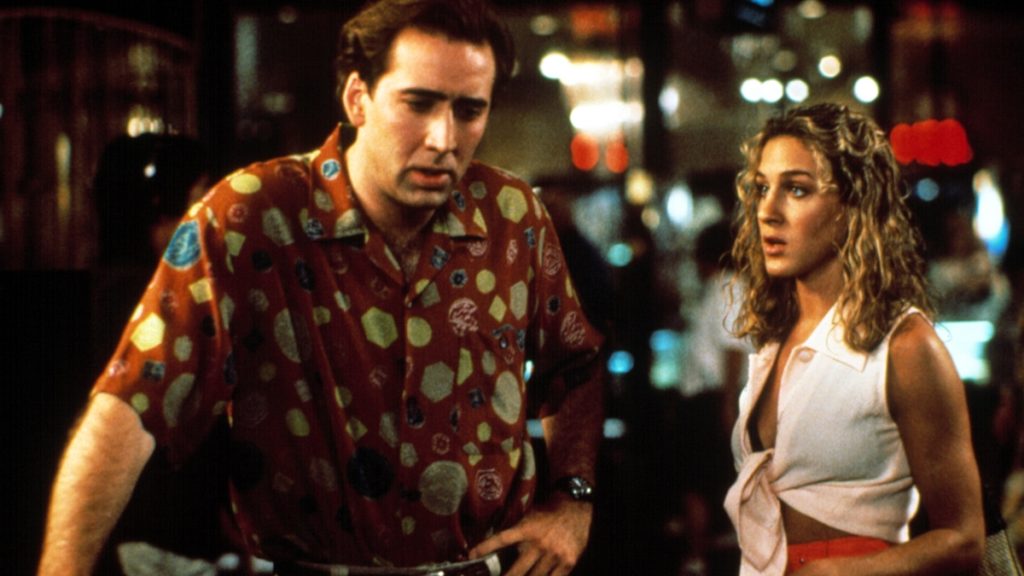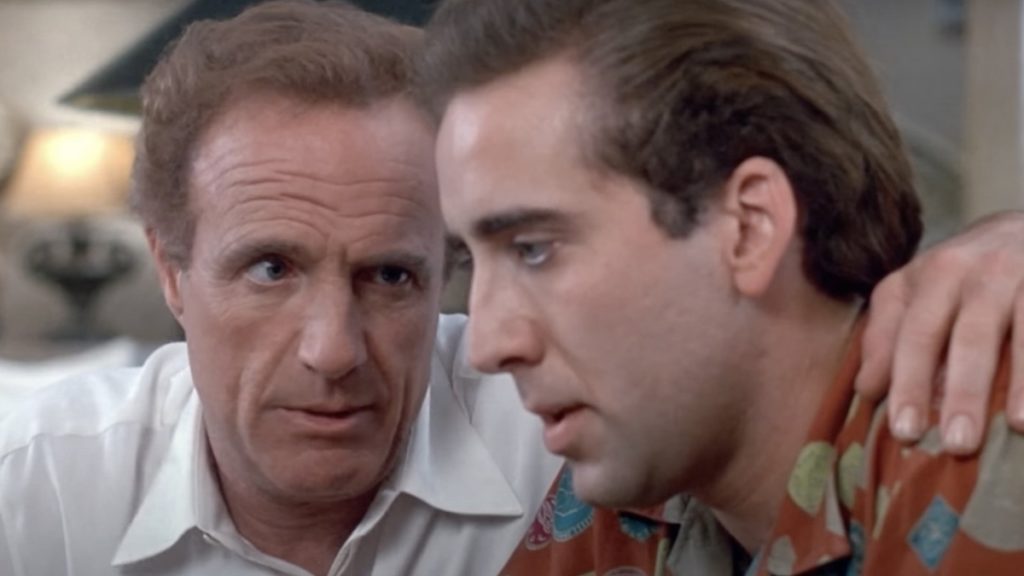The 90s romcom gives viewers a chance to appreciate an underrated tool in James Caan’s repertoire and too infrequently mentioned comedic screenwriter/director.
When James Caan passed away back in July, most of the celebrations of his life and career focused on the tough guy persona that he developed via such classic films as The Godfather (1972), The Gambler (1974), and Thief (1981), to name just a few. All of those are undeniably worthy of tribute, of course. However, many remembrances failed to note his adeptness in comedies, especially those that allowed him to have fun with his macho screen image.
Perhaps the most notable of these turns was Honeymoon in Vegas, an inspired contemporary take on the classic screwball comedy. It works in no small part thanks to the smart decision to cast actors like him and Nicolas Cage (who at the time was still perhaps most famous for being the weirdo who ate a live cockroach on screen in Vampire’s Kiss) in a genre for which most people would deem them unsuitable.
Cage stars as Jack Singer, a private detective who made a vow to his mother (Anne Bancroft in a very funny cameo) on her deathbed that he would never get married. However, his longtime girlfriend Betsy (Sarah Jessica Parker) wants to get hitched and start a family and do so soon. He finally agrees, proposing they fly to Vegas for a quickie wedding.
Before the ceremony, Jack, a bit of a gambler, gets involved in a high-stakes poker game (high enough that Jerry Tarkanian is one of the other players), and when he gets what appears to be an unbeatable hand, he borrows $65,000 to stay in the game. Alas, he comes up short and finds himself in debt to professional gambler and tough guy Tommy Corman (Caan). Tommy’s not the kind of guy you want to owe a pack of gum to, let alone that amount of cash.

However, in lieu of breaking bones and puncturing organs, Tommy proposes an alternative to erasing the debt—he gets to spend the weekend with Betsy. Naturally, Jack and Betsy are appalled. Still, when Tommy concedes to no sex, the desperate couple agrees. It seems to be the best way out of a bad situation.
What neither knows is Tommy started this plan in motion the moment he laid eyes on the happy couple. Betsy, it seems, bears a striking resemblance to the loan shark’s beloved late wife. Jack never had a chance at winning in poker because Tommy rigged it all to force the couple to make that ridiculous deal. With that hurdle cleared, Tommy plans to fly her to his lavish Hawaiian beach house, where he can spend the weekend wooing her away from Jack. (Yes, this makes Honeymoon in Vegas seem like a spoof of the somewhat similar Indecent Proposal, which is even funnier when you consider how that film came out seven months after this one.)
Jack finally figures out what is happening and flies to Hawaii to get Betsy back. Unfortunately, he winds up in the cab belonging to Mahi Mahi (Pat Morita), a friend of Tommy’s. The cabbie has promised to keep Jack far away from the house, taking him on a wild goose chase that includes a visit to the crackpot Chief Orman (Peter Boyle, seemingly doing a bizarre riff on Marlon Brando). Eventually, Jack still finds his way to Betsy, but Tommy has him arrested before he can do anything. His rival out of the way, the loan shark sweeps Betsy back to Vegas for their own wedding.

Meanwhile, Jack gets out of jail and immediately races to stop the ceremony. This culminates in an encounter with. . .well, if you have seen the film, you know exactly who I mean. If you haven’t, I will not ruin it for you.
The film was written and directed by Andrew Bergman. If the name is not immediately familiar to you, know that he has long been one of the vital unsung architects of contemporary American screen comedy. As a writer, he worked on the scripts for such favorites as Blazing Saddles, Fletch, and Soapdish. Most impressively, he penned what may be the funniest non-Marx Brothers film I have ever seen, The In-Laws. As a director, he has his initial struggles. So Fine was a funny film that inexplicably failed to find an audience. His attempt to make lightning strike twice with In-Laws co-stars Peter Falk and Alan Arkin, Big Trouble, went so severely sideways that he left the project in the middle of filming, only to be replaced by renowned comedic mind John Cassavetes.
He finally had a hit in 1990 with the release of The Freshman, managing to get a sly comedic performance out of no less a figure than Marlon Brando in a role that goofed on his Godfather image. (The strife between the two stemming from a brutal interview Brando did suggests there may be more to Boyle’s performance than meets the eye.)
[M]any remembrances failed to note [James Caan’s] adeptness in comedies, especially those that allowed him to have fun with his macho screen image.
Like most of his projects, Honeymoon in Vegas was a throwback to the classic Hollywood screwball comedies of the Thirties (a cinematic period that he thoroughly explored in We’re In the Money, a doctoral dissertation on the subject published in 1971). Indeed, save a few jokes dealing with contemporary elements or things that wouldn’t have gotten past the Production Code, the dream cast of your choice could have easily told this story in the 30s without missing a beat.
As with the best of those films, Bergman starts with an absurd premise but approaches it completely reasonably and logically. It never overtly piles crazy upon crazy and is all the funnier for it. Take the big climax—again, no spoilers—for example. On the surface, it makes for a funny, if absurd, joke, but what makes it work so wonderfully is that Bergman has set everything up. As a result, the sequence feels like the logical procession of what preceded it instead of just a final left turn into silliness.

The film also works to a considerable degree due to the inspired casting of the three leads. Although Moonstruck had been a hit, few people back then would have considered the likes of Cage for the role of a fairly conventional romantic comedy lead. However, his offbeat persona successfully adds another layer of oddness to the proceedings without upending them. Likewise, Bergman does a similar thing with Caan that he did with Brando in The Freshman, letting him have fun with his image.
The twist is that while the Brando turn was basically a joke—albeit an inspired one—Caan’s performance has more nuance. He can tap into Tommy’s softer side in a way that quietly ups the stakes by allowing us to feel some degree of sympathy for him. Parker has the least interesting of the three leads. Still, as she had done a couple of years earlier in L.A. Story, she takes what could have been a nothing part and invests her with enough quirky energy to make one understand why these two guys would go to such absurd lengths to win her heart.
When Honeymoon in Vegas premiered at the tail end of the summer of 1992, it proved to be a success with critics but only a modest hit in theaters. However, its audience would grow over the subsequent years thanks to home video and cable. It proved such a success in those venues that Bergman adapted it into a 2015 stage musical on Broadway.
The fact that Bergman has not directed a film in over 22 years is a true loss, especially for fans of screen comedy that manages to be both elegantly constructed and very funny.
As for his film career, Bergman would have another hit a couple of years later with another Cage-led farcical romantic comedy, It Could Happen to You. Then, in 1996, he wrote and directed an adaptation of Carl Hiassen’s Striptease. It has some very funny things going for it, including a hilarious supporting turn from Burt Reynolds as a randy Florida politician, that make it better than its reputation would suggest. Unfortunately, the controversy surrounding star Demi Moore’s paycheck dominated any press about it and it fizzled at the box office. His last directorial effort to date was the misbegotten Jacqueline Susann biopic Isn’t She Great. The less said about that, the better.
Although perhaps not quite as outrageously inspired as The In-Laws or The Freshman, Honeymoon in Vegas still looms considerably over most things passing for comedy these days. More significantly, a revisiting of the film can serve as a reminder that when we lost James Caan, we lost not just a cinematic tough guy but a consummate actor, one who could be funny as well as ferocious.